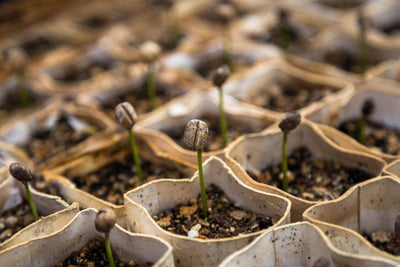Sustainable Events: What Are They & How You Achieve Them?
September 08, 2021Events are all around us. In our personal lives, this can be for weddings, birthdays, anniversaries, or other important dates. Professionally it can entail meetings, conferences, and exhibitions, among other events. Since events often involve crowds, they naturally produce more waste. But did you know that with a little planning and preparation, sustainable events are within reach?
The following article provides several ideas that can be used to make any event a sustainable one. Find out how to reduce the amount of waste produced at events below.
Read on if you’re considering arranging an event, and want to reduce the amount of waste you produce.
What Is Sustainability And A Sustainable Event?
Firstly, it’s important to understand what both sustainability and sustainable events are. Sustainability refers to the efforts to reduce the depletion of natural resources. In doing so, the aim is to achieve ecological equilibrium. Ultimately then, sustainability is concerned with safeguarding the environment.
An event is sustainable if it does not cause environmental harm. Achieving this requires a lot of planning and organization. There needs to be a reduction in energy consumption, limitations to the amount of waste produced, and the implementation of recycling and composting measures. If these conditions aren’t met, especially for larger gatherings that occur every day around the world, the planet will continue to suffer.
All in all, events can produce four main waste streams. These are:
- Compost
- Recycling
- Waste to energy
- Donations (items that were bought for the event and will not be used in the future).
Here’s how to address these four waste streams and make events more sustainable.
The Starting Point
As you embark on your sustainable event journey, you first need to make an important decision. Do you intend to organize this all yourself, or would you prefer to hire event planners? If you would rather outsource this organizational work, you will need to do some research. That’s because not all professional planners will prioritize sustainability. Spend a little time searching for a company with experience arranging zero-waste events. The right business will have the capacity to source a range of green products and also know where to find vendors who operate sustainably.
If, alternatively, you are keen to organize everything independently, you will have to take care of all this yourself. Some useful guidance on how you can achieve this is provided further below. Just bear in mind, though, that generating some waste is unavoidable. Public health laws will likely require you to have trash bins where food is being prepared. Caterers, for example, often rely on single-use items such as plastic gloves and hair nets, which can be out of your control. Where possible, do your best to have these sent to a waste to energy plant rather than a landfill.
The Steps For Organizing Sustainable Events
1. Identify a green location to host the event
The first important step in organizing your sustainable event is picking an ideal site. Fortunately, many cities now have climate action teams or sustainable planning units. These are dedicated teams with relevant expertise and knowledge. By contacting these officials, you can get some handy assistance, including the necessary local sustainability information.
In addition to this, they can offer guidance around any policies and laws you need to adhere to. Some venues will even offer event organizers comprehensive green-event packages.
There are other useful resources that can help you identify sustainable locations as shown below.
- The Green Venue Report is an industry-wide effort to gather sustainability data. It informs readers about the best eco-friendly venues.
- The sustainability scores of specific cities and regions also give event organizers valuable information.
2. Pick a venue which prioritizes sustainability
Once you have decided on a location, you can begin searching for the right venue there. To begin with, try finding venues that have independent certification. You can check which ones do through certifying organizations, such as LEED and Green Key.
There are also many issues you should consider when making this choice. Firstly, what waste management capabilities does the venue have? Understanding this will reveal what collection services you’ll have to implement. For example, the venue might not have composting infrastructure for food waste. If so, you will have to arrange for this and for the collection of the compost.
If the venue does the catering, what ingredients are on the menu? Do these foodstuffs come with a substantial amount of packaging? Make sure you establish precisely what the waste output will be from the kitchen. Then put in place the appropriate measures to deal with all of this. This could include steps like setting up recycling bins and composters.
Is your event going to be fairly lengthy? You may need extra staff on different shifts. Should this be the case, you’ll need to think about how to ensure each shift follows the new procedures you’re introducing. Running some short training sessions for all staff beforehand could be the best way to achieve this.
3. Locate a venue that is central and has great public transport links
When planning your green event, consider the distance and travel involved for attendees. It’s best practice to minimize the pollution caused by their travel to and from your event. There are two variables to bear in mind here. Firstly, how close is your venue to the majority of attendees’ locations? For example, you might be holding a conference for teachers in a certain district. If so, try to pick a venue that is as close to this district as possible.
The second issue is the extent to which the venue can be accessed by public transport. If the event is somewhere remote, people will have no choice but to drive there. This will generate considerably higher levels of greenhouse gasses. Try to find somewhere that is easy to access via bus or train. Then, do your best to encourage attendees to travel using these methods.
It goes without saying that this will not always be possible. Sometimes you may have little choice but to use a remote venue. When this is the case, there are still measures you can take to reduce the total pollution being produced. For example, you can organize a shuttle bus to and or from a more central location.
It means multiple people can use the same vehicle, thereby reducing greenhouse emissions.
4. Inform people in advance about the sustainability of the event
Signpost the sustainable nature of your event at the earliest possible opportunity. Make sure the invitations and all publicity foreground show that the event is eco-friendly. It can help people to get in the right mindset before arriving and make them more prepared to reduce their waste output.
5. Choose your vendors with care
Speak with each of your vendors before agreeing to work with them. Check that most if not all their packaging is reusable, compostable, or recyclable. As earlier stated, the venue might be able to help with this. Ask if they can provide lists of green vendors. If not, reach out to the municipal authority as an alternative for a similar service.
6. Remove the general trash cans
At your event, attendees will only be given recyclable or compostable materials. Because of this, it is a good idea to take away general waste bins. Instead, only have composting and recycling receptacles that are clearly marked. At the start of the event, you can draw the guests’ attention to these, encouraging them to put items in the correct bin. In turn, it will make it easier for you to efficiently manage the different waste streams.
7. Provide a sustainable source of drinking water
Plastic bottles are one of the most damaging products to our environment. These single-use items wreak havoc on our oceans and landmasses. You can minimize the use of these items at your event by supplying drinking water through taps or other green sources that aren’t bottled water.
8. Minimize energy waste
As previously stated, there are certifications like LEED available for green venues. LEED (Leadership in Energy and Environmental Design) certification guarantees efficient energy use. By picking one of these venues, your event will produce substantially less waste.
However, venues without certification aren't necessarily inefficient. There are a few questions you can ask to help assess your options. For instance, can you keep the lighting to a minimum during preparation and cleaning up? Likewise, is it possible to keep the air-conditioning or heating off during these periods if conditions permit? Answering questions like these will help you ascertain a venue’s sustainability.
9. Avoid using paper
The paper industry causes significant harm to our environment. Do your best to avoid contributing to this process by going digital. Rather than printing flyers and leaflets, send emails and use social media. Direct people to an event website and display all the important information there. This will significantly reduce the amount of waste your event produces.
10. Research what happens to the waste
Do a bit of research into the waste collection services that you’re using for the event. Make sure that the recyclable materials really are being recycled. Similarly, check that all compostable goods are actually getting composted.
Get Started With Your Own Sustainability Event
And there you have it. That’s how to organize sustainable events. With a better understanding of what sustainability means in this context, and why it’s important, your very own zero-waste event is achievable. Use the helpful tips above to get started and put on a function to remember!
MORE Going Zero Waste ARTICLES View all ›
Ready to make
the switch?
- Powerful Cleaning
- Dissolves Easily
- Skin-Friendly
- Eco-Friendly
- No Mess

















